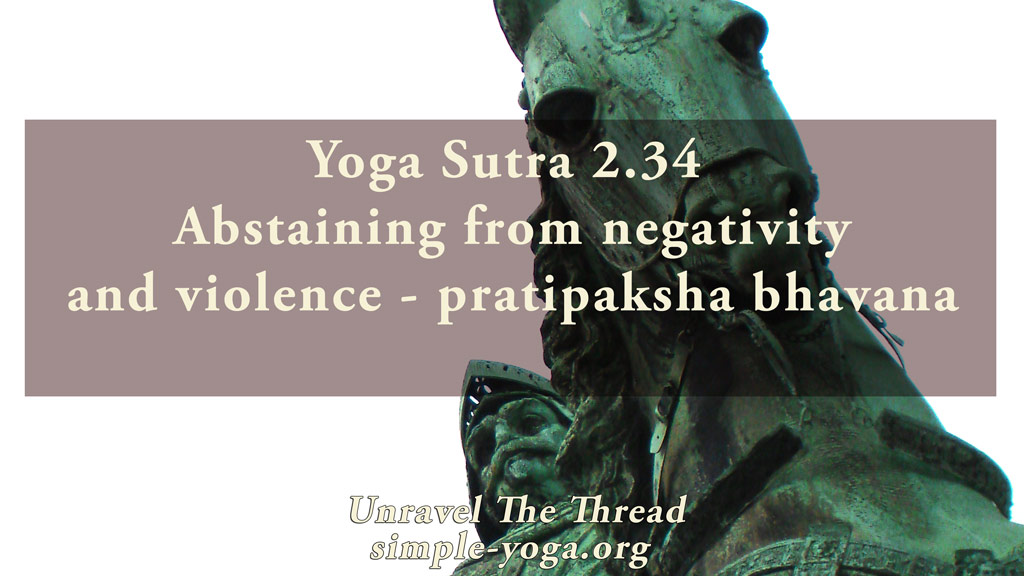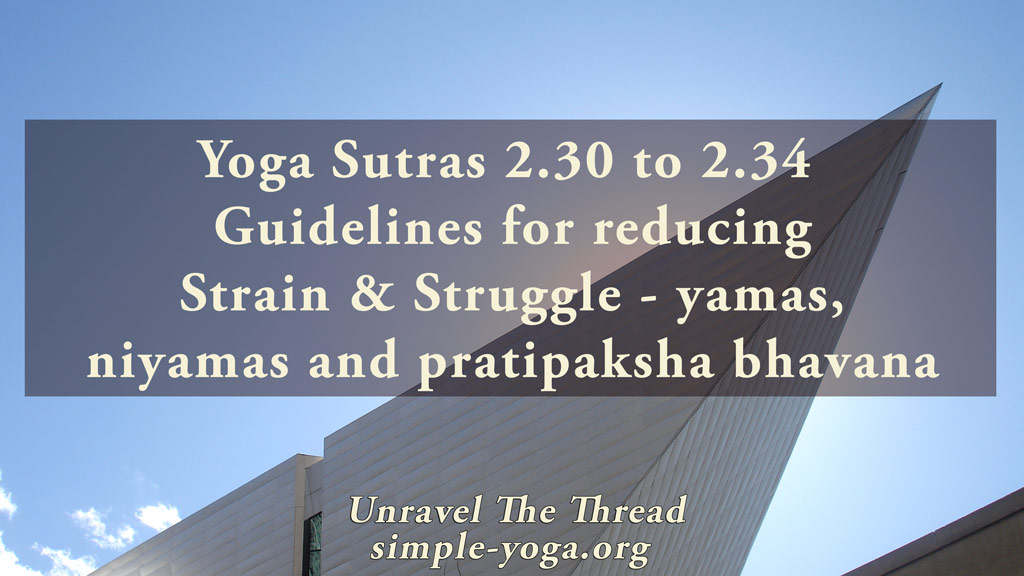
2.34 Abstaining from negativity and violence
December 1, 2020Yoga Sutras 2.30-2.34: Guidelines for reducing strain and struggle
December 7, 2020
2.34 Abstaining from negativity and violence
December 1, 2020Yoga Sutras 2.30-2.34: Guidelines for reducing strain and struggle
December 7, 20202.30-2.34: Guidelines for reducing strain and struggle

These three sets of guidelines , yamas, niyamas and pratipaksha bhavana, offer you ways to release strain, struggle, and self-judgement by creating harmony within you and around you through life affirming intentions, thoughts, and actions. Consider that at every moment you are reaping the harvest of your previous actions. The results tend to be of similar kind to the initiating action. In many cases, particularly when you are entangled in your relentless internal dialogue and focus on the past or future, you tend to overlook what is happening in the most important moment in your life, the moment that you are in. Thus, if you are not present, you may not be cognizant of some of your subconscious actions resulting from your deeply entrenched ways of being, and you end up surprised by experiencing the effects of these subconscious actions. From a very simple and practical perspective, the yamas, niyamas and pratipaksha bhavana are an efficient energy management system so that your energy is not generating more agitation but instead contributing to enhance the quality of your life.
Some of your ways of being can be deeply influenced by one fundamental assumption about the world. This assumption is revealed by your answers to these two questions: Do you see the world and yourself as inherently good or bad? and Do you see the world as a dangerous place filled with hostility and ruthless competition, or do you see the world as a place of harmony and cooperation? This fundamental assumption may also apply to the way you see yourself: Do you see yourself as inherently good, complete, and whole as well as capable and worthy of unconditional love or do you see yourself as an incomplete and fundamentally flawed person undeserving and incapable of unconditional love? Examining your dominant viewpoint on yourself and the world can be illuminating. As you contemplate your fundamental assumptions, you may be better able to see if your actions are motivated by fear or by trust. A similar approach is to compare what happens when you act out of fear and anger with what happens both internally and externally when you act out of friendliness, compassion, inspiration, and equanimity (as advised in 1.33). This inquiry can be useful in trusting the yamas, niyamas and pratipaksha bhavana for bringing more conscious awareness to your everyday actions and interactions.
As usual, your experiments with these ideas validate if these sets of guidelines, yamas, niyamas, and pratipaksha bhavana, provide a viable and sustainable path leading you to step out of a cycle of fear and suffering. These guidelines are instrumental in resolving the emotional challenges limiting your perspective. As a result, you can allocate the energy you were investing in reactivity and suffering towards flowing gracefully with the ever-changing movement of life inside you and all around you. Just like you are not separate segments of body, mind, emotions, and breathing but a complete whole, working together with all systems integrated and interrelated, the yamas, the niyamas, and pratipaksha bhavana are complementary practices. Initiating any of the aspects of these practices will likely invite some of the other aspects into your life. Of course, do not take my word for it, try it out and see what happens for you. Like with anything else, try to use each one of these techniques according to your level of ability and commitment to notice what happens. One more thought, rather than trying to accelerate this process, be curious to observe its own harmonious rhythm as you apply these guidelines with patient and gentle persistence (abhyasa & vairagya) while attending to any changes that you notice to see if their effects agree with you. The next sutras list the effects of mastering each one of the yamas and niyamas. Remember that the effects of the practice move in a range encompassing a wide variation from simple and easy to extraordinary.
If you prefer, you may listen to the podcast:
Unravel the thread is now available as a book!
If you find Simple-Yoga.org and Unravel the thread useful, consider supporting my labor with a donation, you may also donate using PayPal or Venmo. Thank you!
